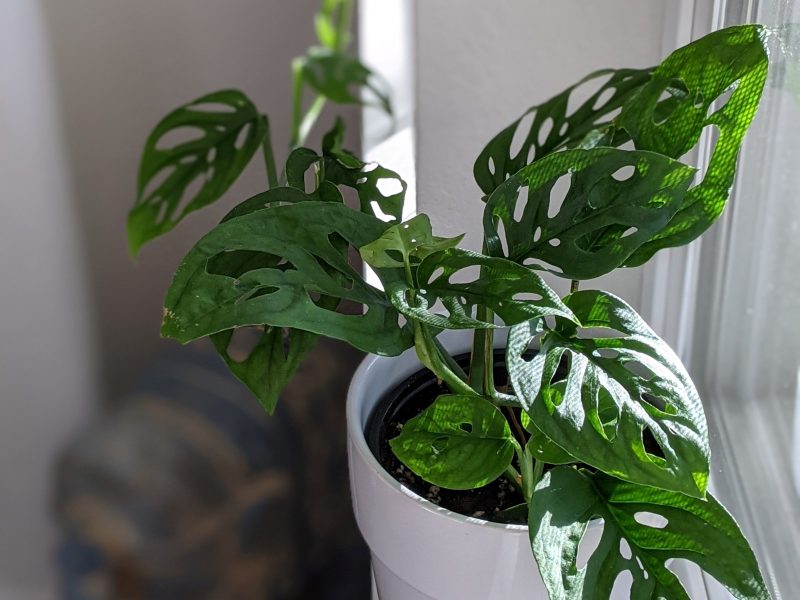
Commonly known as either the Monkey Mask Monstera, Swiss Cheese Vine or Five Holes plant, the Monstera Adansonii are becoming more and more popular in the houseplant world and we totally understand why! Their unique leaves and ability to either be a trailing plant or a tall one means it’s versatile while also being one of the prettiest houseplants around.
Native to the tropics of South and Central America, the Monkey Mask Monstera is mostly known for its foliage. What makes this plant quite unique is that its leaves have holes in the centre and the edge of the leaf is solid. This is different to the famous Monstera Deliciosa, which often has splits right to the edge of the leaf.
These plants have some specific requirements when it comes to keeping them happy but once you nail down a few particularities, they can adapt to and thrive in the majority of homes.
Below you will find all the information you need to care for your Monkey Mask Plant and make sure that it rewards you with luscious new foliage.
How to care for a Monkey Mask Monstera
There are a few essential things to know to keep your plant happy and the most important factor for this variety is humidity. These plants have very delicate thin leaves which means high humidity is essential to prevent dry leaf tips and edges. Get into the habit of misting your Monkey Mask Plant at least a few times a week and use a humidity monitor to keep track of any major fluctuations before they cause any issues with your plant.
The next important factor is allowing the soil of your Monkey Mask Monstera to fully dry out between waterings. If you aren’t doing this then the risk of root rot will dramatically increase. This can cause issues such as yellow leaves, soft droopy vines and a lack of new growth.
The third pillar of care is lighting and with these types of plants, it’s actually really simple because they can tolerate and adapt to pretty much all light levels apart from intense direct sunlight. You will see slower growth in lower light levels and your plant may lose some of the holes but it can survive.
Monkey Mask Monstera Overview
Origin: Central and South America
Plant Family: Araceae
Difficulty Level: Medium
Appearance: Thin delicate leaves with holes forming from the main vein.
Height and Size: Can trail up to 3m
Growth Rate: Medium
Flowering: Can produce white flowers, however, this is rare and are often insignificant.
Pruning: Do not need regular pruning so only remove leaves when there is an issue.
Cleaning: Dust the leaves every few weeks to avoid build-up.
Light Requirements: Bright but indirect light
Water Requirements: Always ensure potting mix has dried out
Best Soil: Well-draining potting mix
Ideal temperature: Average room temperature
Fertilizing Routine: Weak fertilizer during the growth period only
Ideal Humidity Level: High humidity is essential.
Propagation: Through stem cuttings.
Repotting Frequency: Infrequent as they like to be somewhat rootbound.
Toxicity: Mildly toxic to pets and humans
Risk of Pests: Spider mites and scale insects are the most common.
Common Problems: Discolouration of the leaves caused by sunlight or watering issues.
Origin of a Monkey Mask Monstera
They are native to the tropical forests and humid jungles of Central and South America.
Monkey Mask Monstera Appearance
You can spot one of these plants mainly by the holes in their leaves, which are in the middle rather than the edge of the leaf. Monkey Mask Plants are smaller than their famous relative the Monstera Deliciosa and grow nicely as trailing plants.
Monkey Mask Monstera Height and Size
These plants can grow up to 3 metres in length but this will take several years and your plant must be in the ideal environment. Although they will naturally grow as trailing plants, the Monkey Mask can be propped up using a moss pole and trained to grow vertically if you prefer.
Growth Rate of a Monkey Mask Monstera
These plants aren’t fast-growing but also aren’t slow growing, they fit somewhere in the middle. During the growth months of spring and summer, you’ll be rewarded with plenty of new growth if the environment and care are right. However, expect your plant to be dormant all autumn and winter. This is nothing to be concerned about, it’s just natural for houseplants to stop growing in the darker, colder months.
Cleaning your Monkey Mask Monstera
They are prone to a build up of dust on their leaves, which not only stops the light from getting to the plant but also makes the leaves look a little dull. We recommend carefully wiping the leaves down with a damp cloth every month or two to keep the leaves looking and feeling fresh.
When wiping the leaves, you want to be very careful that you don’t damage or rip them as they are particularly thin in places. Using a feather duster can be beneficial here.
Monkey Mask Monstera
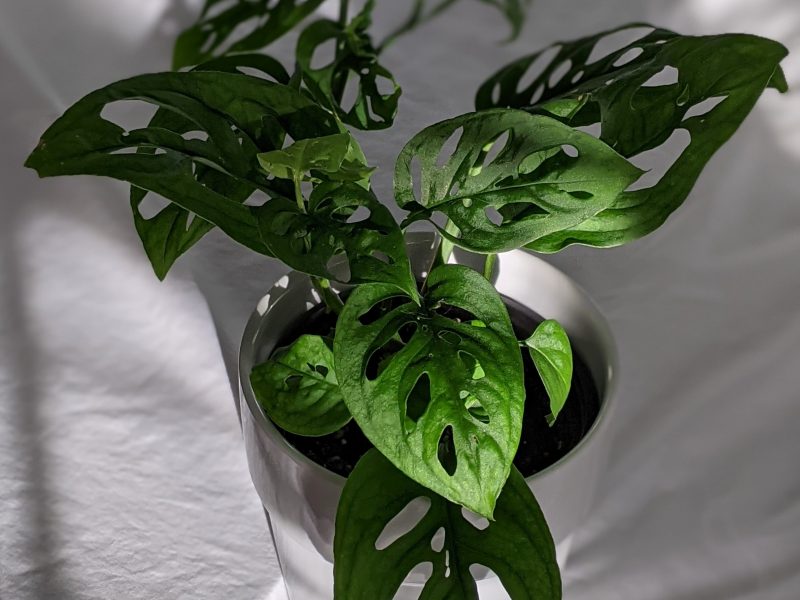
Light Requirements for a Monkey Mask Monstera
One thing that makes caring for these plants quite easy is that they can survive in a range of light conditions. You want to make sure to stay away from intense direct light as this can quickly scorch the leaves and dry them out as they are so thin.
When growing in lower light conditions, plant growth will be slower and you may notice that new leaves are more solid and have fewer holes. This is your plant’s way of maximising the amount of light it is exposed to.
Water Requirements for a Monkey Mask Monstera
Make sure that you allow enough time for the soil to dry out between waterings as this will over time cause root rot. Using a moisture meter to determine when to water your plants is the best way to track moisture levels as we recommend against strict watering schedules. There are so many factors such as plant maturity, pot size and temperature that impact how much you need to water your plant so using a moisture meter can help track these differences.
We recommend watering your Monkey Mask Monstera once a week in the growth months and fortnightly over winter but use this as a guide and adjust where necessary.
Best Soil for a Monkey Mask Monstera
Use a well-draining potting mix for your plant to ensure that excess water can flow through the soil. If the soil doesn’t already contain some perlite, then we recommend adding this in to help with drainage but also aeration of the soil.
The ideal temperature for your Monkey Mask Monstera
Luckily for us Monkey Mask Plant owners, they are not too fussed about temperatures. As long as your home doesn’t reach below 10ºC for extended periods of time, you should be fine.
But it’s not just cold temperatures that you need to be concerned about when it comes to keeping your plant thriving as hot air can really quickly dry out their leaves. You want to make sure that you keep your plant at least 1 meter away from cookers, radiators or heating vents. Hotspots can also form quickly around windows that receive a lot of sunlight in summer so monitor the environment for these as well.
We highly recommend buying a digital thermometer if you don’t already have one as they will help you spot fluctuations as they happen.
Monkey Mask Monstera Fertilizer Requirements
As with most other houseplants, you should only feed your Monkey Mask Plant in spring and summer as they will go through a more dormant growing period in the colder months.
We recommend using a fertiliser at half strength to avoid damaging the root system. Sometimes the amount listed on the bottle can be too much for your Monkey Mask Plant as they have a very delicate root system and thin leaves. This liquid feed is our favourite and is suitable for most houseplants.
Ideal Humidity Level for your Monkey Mask Monstera
It is important that you regularly mist the leaves of your Monkey Mask Plant to increase the humidity levels as they thrive in high humidity. As they are native to the humid jungles of Central and South America, if you can mimic this environment a little bit, you will dramatically increase the happiness of your plant.
Mist your plant using a spray bottle, or invest in a humidifier for a more regular boost to the humidity level.
These plants also grow really well in bathrooms and kitchens due to the increased levels of steam from showering and cooking so if there is a spot that receives a good amount of natural sunlight in either of these rooms, this can be a great option for your plant.
Monkey Mask plant propagating in water
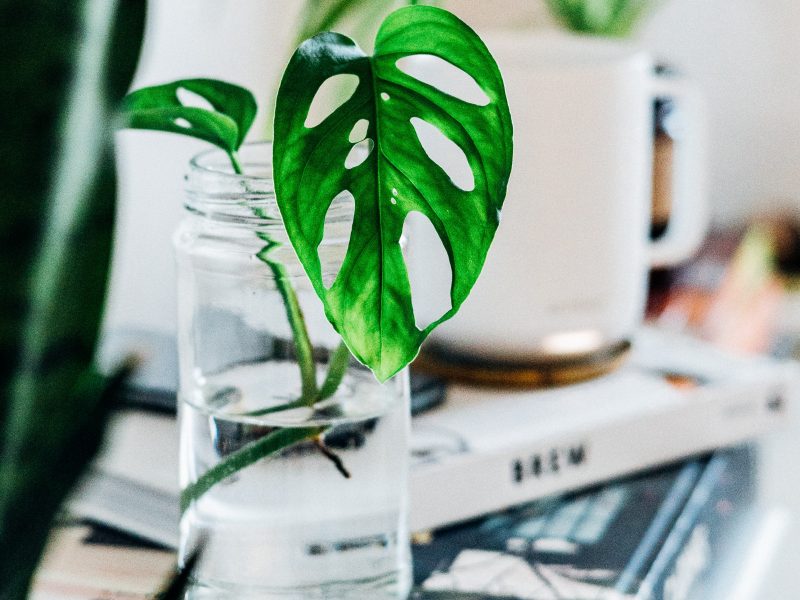
Propagating your Monkey Mask Monstera
The easiest and most successful method of propagating these plants is through stem cuttings. We have a whole guide on propagating your Monkey Mask so check that out for more information.
Repotting your Monkey Mask Monstera
You don’t need to worry about repotting for a few years as Monkey Mask Plants actually like being a little bit root bound. If they are in a pot that is too big for them, it can cause your plant to become unstable. It also increases the risk of root rot as the soil will take longer to dry out when there is more of it.
Aim to repot your plant every 2 years, or sooner if you spot signs that it is severely root bound. These include roots coming out of the drainage holes or the top of the pot and stagnant growth in summer.
Flowers on a Monkey Mask Monstera
As they are part of the Araceae plant family, the Monkey Mask Monstera can occasionally produce white flowers. However, this is extremely rare when grown as a potted plant outside of its natural environment.
Pruning your Monkey Mask Monstera
You don’t need to be regularly cutting the vines back so there are only really two reasons why we would prune a Monkey Mask Plant. Firstly, if there are issue areas on your plant – so we are talking brown or yellow leaves here. Once the majority of the leaf has discoloured, it’s no longer serving your plant and it’s best to remove it.
The second reason you might want to get the pruning scissors out is if the vines have become particularly leggy. This can happen over winter or in low-light areas and pruning these parts off can help your plant look a little fresher.
Monkey Mask Plant Leaf
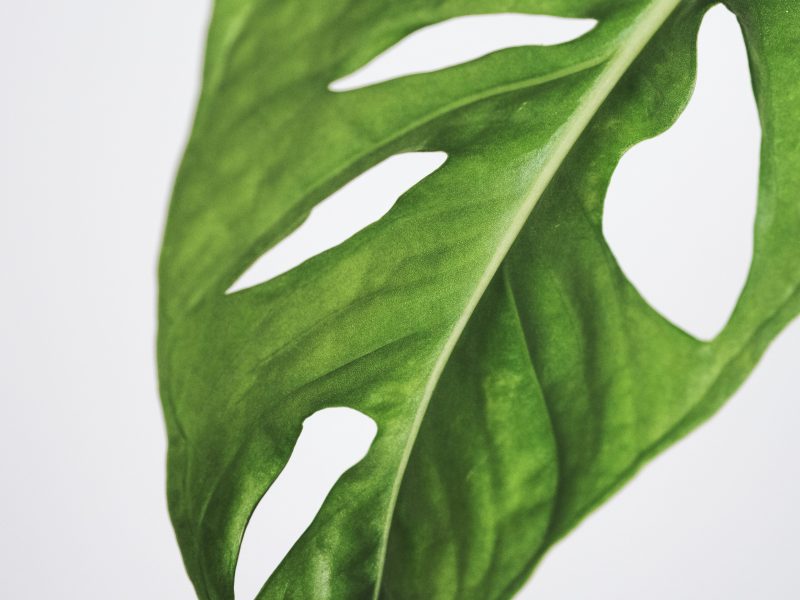
Monkey Mask Monstera Toxicity to Humans and Pets
Unfortunately, Monkey Mask plants are mildly toxic if ingested or if they come into contact with your eyes so it is really important that you keep the plant away from pets and small humans that might try and eat parts of the leaves.
If your pet does nibble at the leaves, they will often be fine if it’s only a small part that they ingested. However, because of the toxicity of Monkey Mask Plants, we do still recommend that you seek advice or treatment from a veterinarian to be sure.
As these plants are toxic, they can cause mouth, eye, throat and stomach irritation if ingested and can also cause vomiting.
Treating and Preventing Pests
Spider Mites and Scale Insects are the most common pests that you will find on a Monkey Mask Monstera.
If you do spot pests then it’s important to isolate your plant from all other houseplants, remove the worst affected areas to curb the infestation, shower your plant and treat it with an insecticide.
You also want to make sure that you look over any plants that were close by as pests can spread across houseplants quite easily.
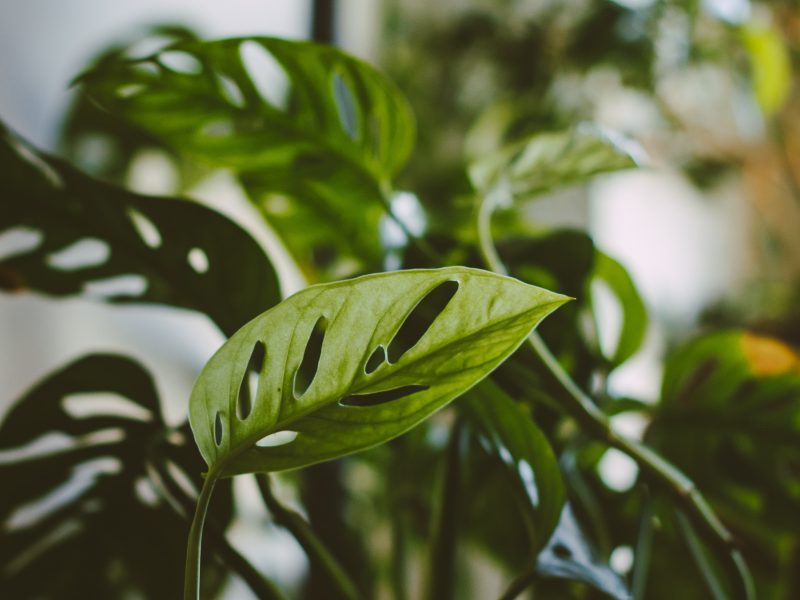
Treating Common Problems
One common issue that you may come across with these plants is brown leaf tips and edges. As they have very delicate foliage, it’s not uncommon for parts to dry out a little bit. It can be unavoidable as creating a humidity level as high as that of the jungle is impossible and uncomfortable. However, regular misting will help to avoid this problem as much as possible.
Yellow leaves on your Monkey Mask Plant indicate that the plant has either received too much light (most probably direct sunlight) or the soil is waterlogged due to overwatering. Use a light meter or a moisture meter to determine if the environment is right.
If you find that the potting mix is waterlogged then this is most probably the cause of the yellow leaves on your Monkey Mask Plant. We recommend replacing the soil immediately and trimming away any rotten roots so your plant can begin to recover. Moving forward, cut back on how frequently you water your plant as you want the potting mix to dry out to prevent any more yellow leaves from developing.
If it’s direct sunlight that is scorching the leaves of your Monkey Mask and causing them to turn yellow, move your plant to a shadier spot in your home.














